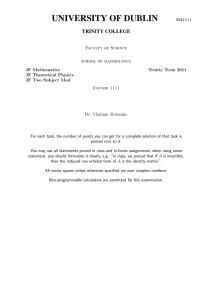The General Linear Group
advertisement
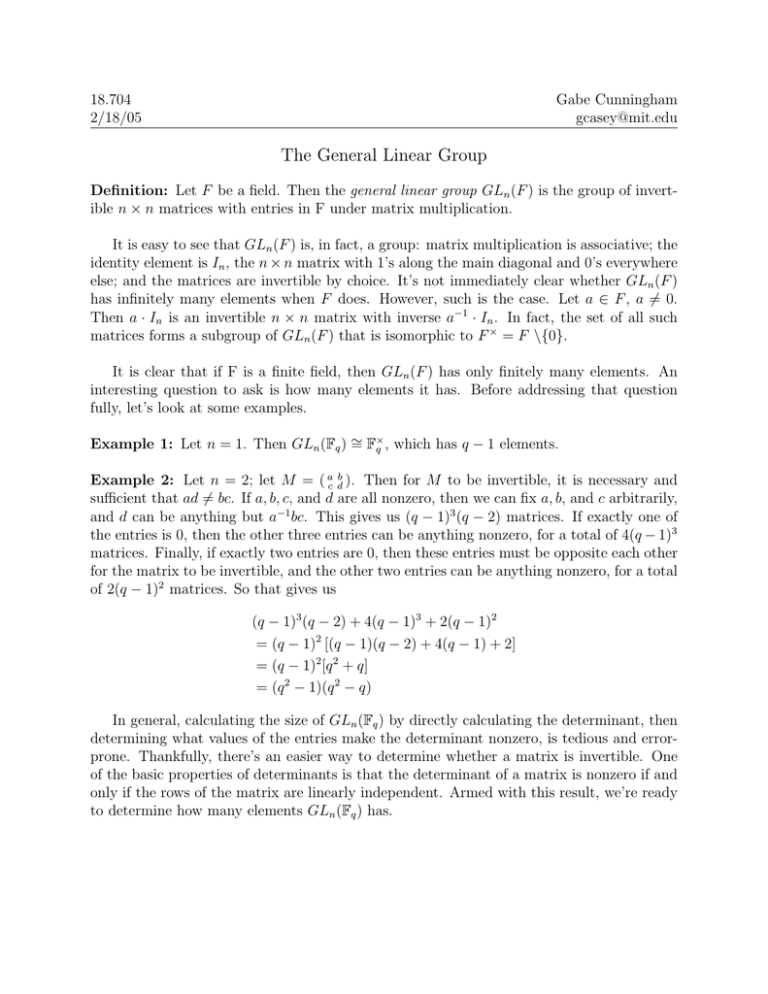
18.704
2/18/05
Gabe Cunningham
gcasey@mit.edu
The General Linear Group
Definition: Let F be a field. Then the general linear group GLn (F ) is the group of invertible n × n matrices with entries in F under matrix multiplication.
It is easy to see that GLn (F ) is, in fact, a group: matrix multiplication is associative; the
identity element is In , the n × n matrix with 1’s along the main diagonal and 0’s everywhere
else; and the matrices are invertible by choice. It’s not immediately clear whether GLn (F )
has infinitely many elements when F does. However, such is the case. Let a ∈ F , a 6= 0.
Then a · In is an invertible n × n matrix with inverse a−1 · In . In fact, the set of all such
matrices forms a subgroup of GLn (F ) that is isomorphic to F × = F \{0}.
It is clear that if F is a finite field, then GLn (F ) has only finitely many elements. An
interesting question to ask is how many elements it has. Before addressing that question
fully, let’s look at some examples.
Example 1: Let n = 1. Then GLn (Fq ) ∼
= F×
q , which has q − 1 elements.
Example 2: Let n = 2; let M = ( ac db ). Then for M to be invertible, it is necessary and
sufficient that ad 6= bc. If a, b, c, and d are all nonzero, then we can fix a, b, and c arbitrarily,
and d can be anything but a−1 bc. This gives us (q − 1)3 (q − 2) matrices. If exactly one of
the entries is 0, then the other three entries can be anything nonzero, for a total of 4(q − 1)3
matrices. Finally, if exactly two entries are 0, then these entries must be opposite each other
for the matrix to be invertible, and the other two entries can be anything nonzero, for a total
of 2(q − 1)2 matrices. So that gives us
(q − 1)3 (q − 2) + 4(q − 1)3 + 2(q − 1)2
= (q − 1)2 [(q − 1)(q − 2) + 4(q − 1) + 2]
= (q − 1)2 [q 2 + q]
= (q 2 − 1)(q 2 − q)
In general, calculating the size of GLn (Fq ) by directly calculating the determinant, then
determining what values of the entries make the determinant nonzero, is tedious and errorprone. Thankfully, there’s an easier way to determine whether a matrix is invertible. One
of the basic properties of determinants is that the determinant of a matrix is nonzero if and
only if the rows of the matrix are linearly independent. Armed with this result, we’re ready
to determine how many elements GLn (Fq ) has.
18.704
2/18/05
Gabe Cunningham
gcasey@mit.edu
Qn−1 n
Proposition 1: The number of elements in GLn (Fq ) is k=0
(q − q k ).
Proof: We will count the n × n matrices whose rows are linearly independent. We do so
by building up a matrix from scratch. The first row can be anything other than the zero
row, so there are q n − 1 possibilities. The second row must be linearly independent from
the first, which is to say that it must not be a multiple of the first. Since there are q multiples of the first row, there are q n − q possibilities for the second row. In general, the ith
row must be linearly independent from the first i − 1 rows, which means that it can’t be
a linear combination of the first i − 1 rows. There are q i−1 linear combinations of the first
i − 1 rows, so there are q n − q i−1 possibilities for the ith row. Once we build the entire
matrix this way, we know that the rows are all linearly independent by choice. Also, we can
build any n × n matrix whose rows
linearly independent in this fashion. Thus, there are
Qare
n−1 n
(q − q k ) matrices.
(q n − 1)(q n − q) · · · (q n − q n−1 ) = k=0
Now we’ll consider an interesting subgroup of GLn (F ). The determinant function,
det : GLn (F ) → F × is a homomorphism; it maps the identity matrix to 1, and it is multiplicative, as desired. We define the special linear group, SLn (F ), to be the kernel of this
homomorphism. Put another way, SLn (F ) = {M ∈ GLn (F ) | det(M ) = 1}.
Qn−1 n
k
Proposition 2: The number of elements in SLn (Fq ) is
k=0 (q − q ) \(q − 1).
Proof: Consider the homomorphism det : GLn (F ) → F × . This map is surjective; that is,
the image of GLn (F ) under det is the whole space F × . This is true because, for instance,
the matrix
a 0 ... 0
0 1 . . . 0
.. .. . . ..
. .
. .
0 0 ... 1
is an invertible n × n matrix of determinant a. Since SLn (Fq ) is the kernel of the homomorphism, it follows from the First Isomorphism Theorem that GLn (Fq )\SLn (Fq ) ∼
= F ×.
Therefore,
Qn−1 n
k
|GLn (Fq )|
k=0 (q − q )
=
|SLn (Fq )| =
|F × |
q−1
18.704
2/18/05
Gabe Cunningham
gcasey@mit.edu
Now, in order to talk about two more subgroups of GLn (F ), we need to define the notion
of the center of a group.
Definition: The center of a group G, denoted Z(G), is the set of h ∈ G such that
∀g ∈ G, gh = hg.
Proposition 3: Z(G) is a subgroup of G.
Proof: 1 is in Z(G) because ∀g ∈ G, 1 · g = g · 1 = g. Let h1 , h2 ∈ Z(G). Then ∀g ∈ G,
h1 h2 g = h1 (h2 g) = h1 (gh2 ) = (h1 g)h2 = gh1 h2 ,
so h1 h2 ∈ Z(G). Finally, if h ∈ Z(G), then ∀g ∈ G,
hg = gh
h hgh−1 = h−1 ghh−1
gh−1 = h−1 g
−1
so h−1 ∈ Z(G).
Now let’s look at the centers of GLn (F ) and SLn (F ).
Proposition 4: Z(GLn (F )) = {a · In | a ∈ F × }; Z(SLn (F )) = {a · In | a ∈ F × , an = 1}
Proof idea: For M to be in Z(GLn (F )), it must commute with every N ∈ G. In particular,
M commutes with the elementary matrices. Multiplying M on the left by an elementary
matrix corresponds to performing an elementary row operation; multiplying M on the right
by an elementary matrix corresponds to performing an elementary column operation. So,
for instance, multiplying the ith row of M by a gives you the same matrix as multiplying
the ith column of M by a. This implies that the matrix is diagonal. Then, since swapping
the ith and j th row of M gives you the same matrix as swapping the ith and j th column of
M , then the ith entry along the diagonal must equal the j th entry along the diagonal, for all
i and j. Therefore, M must be a multiple of In . Finally, it is easy to see that all nonzero
multiples of In do commute with all N ∈ G. So the proposition is proved for Z(GLn (F )).
The proof for Z(SLn (F )) is similar.
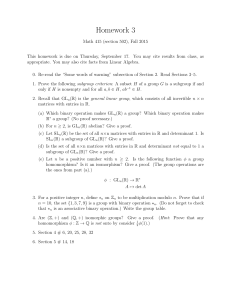
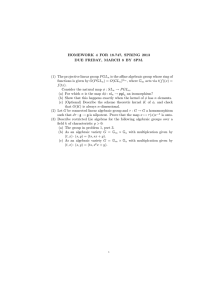
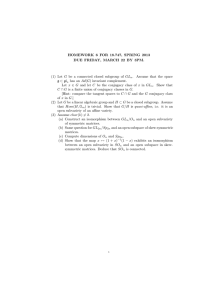

![Quiz #2 & Solutions Math 304 February 12, 2003 1. [10 points] Let](http://s2.studylib.net/store/data/010555391_1-eab6212264cdd44f54c9d1f524071fa5-300x300.png)
